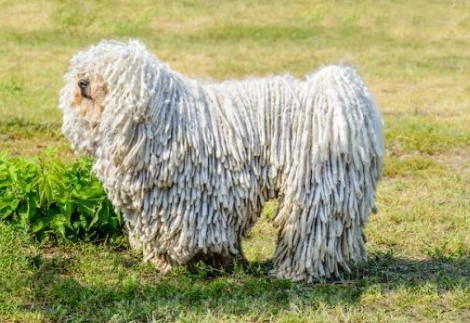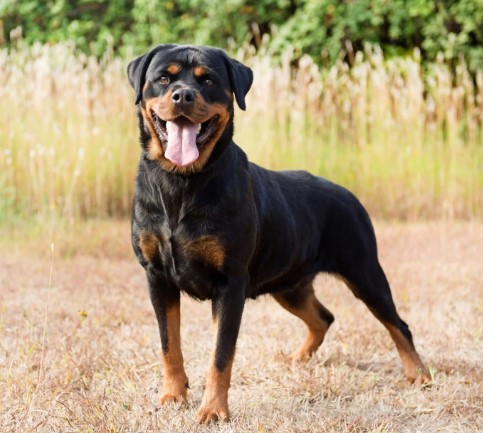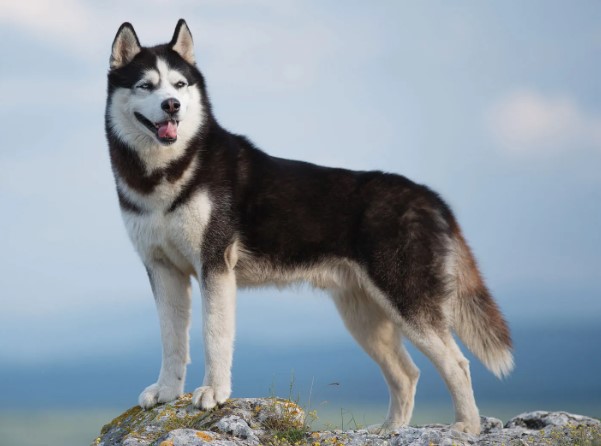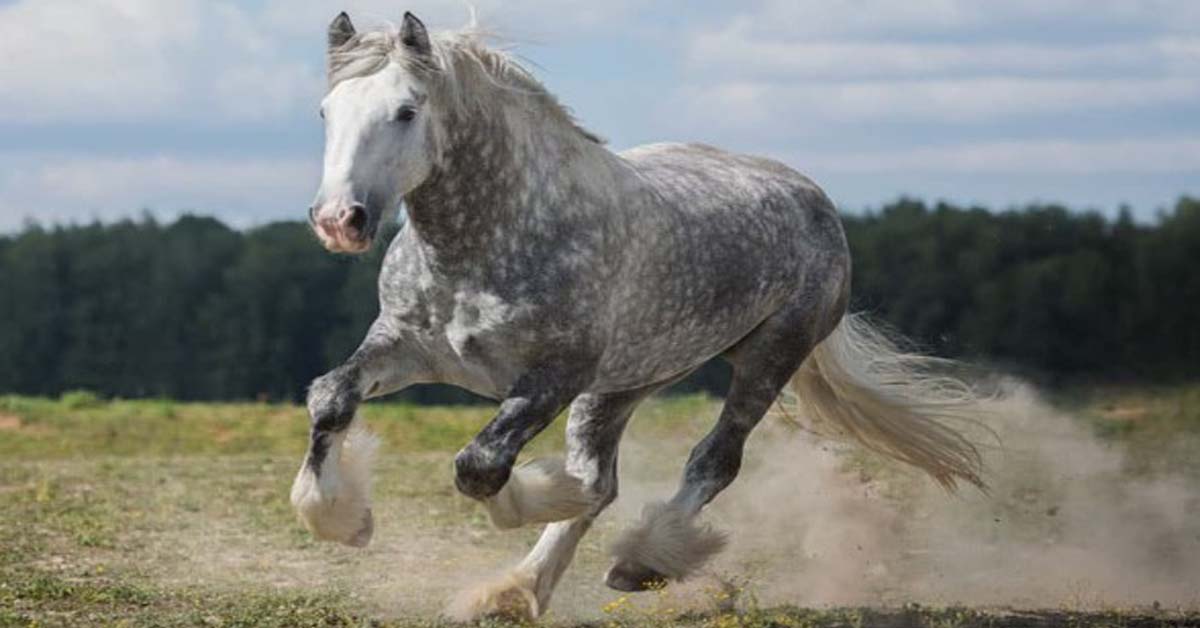Introducing the Komondor Dog
The Komondor Dog, hailing from Hungary, is a robust and sizable canine breed. It is renowned for its unique corded fur, which can grow notably lengthy and dense. Often referred to as the Hungarian Sheepdog or Hungarian Komondor, this breed’s historical role was that of a guardian for livestock, showcasing a steadfast protective instinct.
These dogs demonstrate unwavering loyalty and devotion to their owners, though they tend to approach strangers with caution. Their robust physique and athleticism necessitate ample exercise and mental engagement. While they possess an independent disposition, appropriate training and socialization can mold them into admirable family companions.
| Origin | Hungary |
| Height | 25 to 27 inches tall at the shoulder |
| Weight | 80 to 100 pounds |
| Life Span | 10 to 12 years |
| Colors | White |
The Unique Characteristics of the Komondor Dog:
The Komondor, also recognized as the Hungarian Sheepdog, stands out for its unique corded coat. This coat is composed of dense, tangled hair that naturally forms cords as the dog matures. Typically, these cords are white and can extend to the ground, giving the dog an illusion of greater size.
Furthermore, the Komondor is renowned for its independence and protective instincts, making it an exceptional choice as a guard dog. In addition to their guarding abilities, they possess a strong herding instinct, as they were initially bred for both guarding and herding sheep.
The Breed Traits of the Komondor Dog:
Family life:
Affectionate with family:
The Komondor dog breed is famed for its affectionate and protective disposition toward its family. They exhibit remarkable loyalty and devotion to their owners, making them wonderful additions to any family. Nevertheless, they may exhibit caution around strangers and might display protective instincts over their family and property.
Early socialization and training can be effective in managing this natural inclination. Additionally, their striking and unmistakable corded coat demands routine grooming and care to maintain its uniqueness.
Good with small children:
The Komondor, a sizable and protective breed, has the potential to become a wonderful family pet when equipped with appropriate training and socialization. They possess a strong protective instinct towards their family and can develop a positive rapport with young children when raised together from an early age.
Nevertheless, as is prudent with any breed, it is vital to oversee interactions between the dog and small children to guarantee the safety of both parties involved. Focusing on training and socialization remains crucial in aiding the dog in adopting suitable behaviors and evolving into a well-mannered family member.
Good with other dogs:
The Komondor dog is recognized for its protective nature and may possess a robust inclination to safeguard its domain and loved ones. They often exercise caution around strangers and unfamiliar dogs, yet through diligent socialization and training, they can acquire the ability to coexist harmoniously with other canines.
Crucially, it’s essential to introduce them to other dogs and individuals during their formative years and sustain ongoing training and socialization throughout their lifetime.

Physical:
Shading layer:
The Komondor, a substantial canine breed, is famed for its luxuriously dense, corded coat. These dogs are prolific shedders, necessitating consistent grooming to uphold their coats and diminish shedding. To minimize shedding, it’s imperative to engage in routine brushing and combing to eliminate loose hair and thwart matting.
Moreover, regular baths are instrumental in eliminating dirt and debris that may become ensnared in the coat, further averting shedding. It’s worth noting that shedding might intensify during shedding seasons, which generally transpire twice a year.
Coat Grooming Frequency:
The Komondor dog, a sizable and fluffy breed, is celebrated for its distinctive corded coat. This unique fur necessitates regular grooming to preserve its appearance and promote the dog’s well-being.
It’s advisable to groom the coat at least once a week, though more frequent sessions may be required if the cords become tangled or soiled. Grooming should encompass the careful separation and untangling of the cords, along with gentle cleansing using a mild shampoo.
Crucially, it’s imperative not to shave a Komondor’s coat, as it may not regrow properly and can be detrimental to their health. These dogs possess a double coat, which serves as vital protection against both heat and cold, making it essential to maintain its integrity.
Drooling levels:
Komondor dogs are recognized for their distinctive drooling tendency, which can be rather pronounced. This is attributable to their loose, pendulous lips and elongated tongues. Originating from Hungary, this breed has historical roots in herding and safeguarding livestock, in addition to serving as guardians for residences and estates.
To ensure their well-being, grooming and maintaining a clean coat is of paramount importance for Komondors. Excessive drooling can result in matting, which in turn may lead to skin-related concerns.
Social:
Openness to strangers:
The Komondor, a substantial and robust dog breed, boasts a reputation for its protective and unwavering loyalty to its family. They tend to approach strangers with caution and might require some time to establish trust. Given their historical role as livestock guardians, their protective instincts toward home and family are entirely natural.
Proper socialization and early training are crucial for their development, enabling them to acclimate more readily to unfamiliar individuals. Employing techniques such as obedience training, socialization, and positive reinforcement can aid the Komondor in becoming more receptive to strangers and at ease in novel environments.
Watchdog/protective nature:
The Komondor, a robust and sizeable canine breed, is renowned for its protective and vigilant demeanor. They possess a potent instinct to safeguard both their family and property, which may lead to wariness around unfamiliar individuals. Distinguishing them further is their distinctive corded coat, which demands regular grooming for upkeep.
In addition to their protective nature, Komondors are characterized by their intelligence and independence. Therefore, they benefit greatly from systematic training and socialization starting from a young age.
Playfulness level:
The Komondor is not known for being an excessively playful dog breed. They tend to exhibit a reserved and dignified demeanor, and their inclination for play may not be as pronounced as in some other breeds. Nevertheless, they derive enjoyment from leisurely walks and quality time spent with their owners.
Their protective instincts towards their families and homes may occasionally manifest as a form of “playfulness” when it comes to guarding their territory.
Adaptability level:
The Komondor is celebrated for its unwavering loyalty and protective nature, yet it is not generally regarded as a highly adaptable breed. Rooted in herding, they are accustomed to working on expansive properties and possess a strong instinct to safeguard their flock. Consequently, they may not thrive in confined spaces or apartment living, necessitating ample room for exercise and play.
Furthermore, their adjustment to diverse settings and scenarios requires thorough socialization and training, commencing at a young age. In summary, Komondors are best suited to rural or suburban environments where they have room to roam and a purpose to fulfill.

Personality:
The Komondor is a robust and sizeable dog breed sporting a unique, shaggy white coat reminiscent of dreadlocks. Renowned for their independence, strong-willed nature, and protective instincts, they are fiercely loyal and dedicated to their families, making them outstanding watchdogs.
Nonetheless, their wariness of strangers and potential aggression toward other dogs necessitate thorough socialization. Training with unwavering leadership proves vital, as Komondors can display stubbornness and strong-mindedness. They thrive best under the guidance of experienced dog owners who can deliver firm, consistent training and socialization.
Trainability level:
Trainability level pertains to a model or machine learning algorithm’s capacity to undergo training or enhancement with fresh data. It quantifies how effectively a model can adjust to evolving conditions or novel insights.
To illustrate, a highly trainable model demonstrates the capability to assimilate new data and enhance its performance, whereas a less trainable model might encounter difficulties when confronted with new information.
Need mental stimulation:
Indeed, Komondor dogs require both mental stimulation and physical exercise. Enhancing their mental acuity involves offering puzzle toys and involving them in training endeavors like obedience and agility. Furthermore, routine walks and play sessions contribute to fulfilling their mental stimulation needs.
Barking level:
The Komondor is generally recognized for its calm demeanor, but, like any canine, it is capable of barking. Nevertheless, the extent of barking can fluctuate based on the specific dog, its training, and social exposure. Certain Komondors may exhibit more frequent barking, while others may be less inclined to vocalize.
Energy level:
The Komondor breed is characterized by its large, muscular build, and it necessitates consistent exercise for optimal health. With a moderate energy level, these dogs delight in walks and runs, while their natural protective instincts may call for extra physical activity and mental engagement to channel their energy positively.
They are less suitable for apartment living and are better suited to homes with enclosed yards.
The Picturesque Komondor Dog: Its History and Origins
The Komondor, often referred to as the Hungarian sheepdog, is a substantial canine breed with its origins traced back to Hungary. Its unique appearance, characterized by a lengthy, corded coat that resembles dreadlocks, has evolved over centuries of selective breeding, primarily for herding and safeguarding livestock.
This breed boasts a rich historical lineage, with traces of Komondor-like dogs dating as far back as the 9th century. Hungarian shepherds held them in high esteem for their proficiency in protecting herds of sheep and cattle against predators and for their role as vigilant watchdogs on farms and estates. The Komondor officially gained recognition from the American Kennel Club (AKC) in 1937.
Read More on en.wikipedia.org
Living With Komondor Dog:
Komondor dogs belong to the category of large, protective breeds originally developed for livestock guarding. They are renowned for their distinctive corded coats, which demand regular grooming to maintain. Given their role as guardians, they tend to be cautious around strangers and may exhibit protective instincts towards their family and property.
Early and thorough socialization during puppyhood, coupled with consistent training and well-defined boundaries, is essential. Given their size and vitality, they thrive in spacious environments that allow for ample exercise and play. While they can make excellent family companions when trained and socialized adequately, they may not be the ideal choice for novice dog owners.
It’s worth emphasizing their strong territorial and familial protective instincts, underscoring the importance of rigorous training to prevent any aggressive behavior.

Appearance:
The Komondor, characterized by its impressive size and muscular physique, boasts a unique coat that resembles dreadlocks. Typically, they exhibit a pristine white coloration and can tip the scales at an impressive 80 to 100 pounds. With a robust, athletic frame and an air of pride and dignity, they stand out.
Originally developed for the purpose of herding and safeguarding livestock, Komondors are celebrated for their unwavering loyalty and protective instincts.
Komondor Dog Temperament: What to Expect
The Komondor is a sizable, self-reliant, and protective dog breed. Originally developed for livestock guarding in Hungary, they often display wariness toward strangers and may maintain a degree of aloofness with unfamiliar individuals. Nonetheless, they are renowned for their affectionate and loyal nature within their family circle.
Early and consistent training and socialization are imperative to prevent them from developing excessive aggression or territorial behavior. Their strong-willed disposition necessitates an owner who is firm and self-assured. Given their substantial size and exercise requirements, apartment living is not well-suited for them.
They thrive in homes with spacious, securely fenced yards. Their dense, corded coat calls for regular grooming.
Komondor Dog Health: Common Issues and How to Prevent Them
Komondor dogs are a robust and muscular breed, distinguished by their unique corded coats. While they generally enjoy good health and vitality, there are specific health concerns to be mindful of.
One prevalent issue among Komondors is hip dysplasia, a congenital condition affecting the hip joint, which can lead to lameness and arthritis, occasionally necessitating corrective surgery.
Another critical concern is bloat, a severe condition characterized by the distension and twisting of the stomach. Swift treatment, often involving emergency surgery, is imperative to save the dog’s life.
To mitigate these and other potential health issues, it’s crucial to provide your Komondor with a well-rounded, high-quality diet, regular exercise, and ample playtime. Routine veterinary check-ups are essential, alongside genetic testing to identify any potential genetic predispositions.
Maintaining the distinctive corded coat of the Komondor is also vital for their overall well-being. Regular grooming is essential to prevent matting and skin irritations.
In conclusion, with proper care, regular veterinary assessments, and diligent grooming, your Komondor can enjoy a lengthy and healthy life.
Care for the Komondor Dog:
The Komondor, a substantial and muscular breed, demands consistent exercise and meticulous grooming to preserve its unique corded coat. Recognized for its independent and protective nature, it excels in roles such as farm and ranch work and safeguarding homes and livestock.
Early socialization and training are imperative to instill good behavior and obedience in Komondors. They may be susceptible to specific health concerns like hip dysplasia and bloat, underscoring the significance of routine veterinary examinations. In summary, the Komondor serves as a loyal and vigilant companion, although it may not be the ideal choice for novice dog owners.
Best Food For Komondor Dog:
- ORIJEN Original Grain-Free Dry Dog Food
- Stella & Chewy’s Chewy’s Chicken Dinner Patties Freeze-Dried Raw Dog Food
- American Journey Salmon & Sweet Potato Recipe Grain-Free Dry Dog Food
See More Food On www.hillspet.com
Feeding Komondor Dog
Komondor dogs, being a large breed, require a protein-rich diet to support their muscle development. Opt for top-quality, grain-free dog food specially designed for large breeds. Accurately portioning their meals based on weight and activity level is crucial to prevent overfeeding and potential obesity.
To ensure a well-rounded diet, consider offering your Komondor a variety of protein sources such as chicken, fish, and lamb. Fresh fruits and vegetables can also be included to provide essential vitamins and minerals. Above all, ensure your dog has constant access to fresh water.

Grooming Tips for the Komondor Dog
The Komondor, an impressive and grand breed distinguished by its dense, corded coat, demands diligent grooming efforts to maintain coat health and prevent matting. Here are some grooming tips for your Komondor:
Regular Brushing: Brush the coat at least once a week to untangle and prevent matting. Start at the cord ends and work your way up, using a slicker brush or wide-toothed comb.
Infrequent Baths: The Komondor’s natural oils help maintain coat health, so limit baths to a minimum. When bathing is necessary, use a gentle, hypoallergenic shampoo, and rinse thoroughly to remove any residue.
Cord Cleaning: Dirt, dust, and debris can accumulate in the cords, so regularly clean them with a damp cloth or cotton swab, being cautious not to introduce water inside the cords.
Avoid Cord Cutting: Refrain from cutting or trimming the cords, as they are a distinctive feature of the breed.
Professional Grooming: Given the complexity of Komondor grooming, consider seeking the services of a professional groomer with experience, patience, and the necessary tools.
Routine Checks: Periodically inspect your dog’s ears and paws for debris or matting, trim their nails, and watch for any signs of infection or inflammation.
By adhering to these grooming guidelines, you can ensure your Komondor’s coat remains healthy and maintains its striking appearance. While grooming a Komondor may be time-intensive, the results are well worth it for a happy and beautiful furry companion.
Training of the Komondor Dog
The Komondor, a substantial sheepdog breed, is renowned for its distinctive corded coat. Training a Komondor necessitates patience, unwavering consistency, and the application of positive reinforcement techniques.
Emphasizing socialization is crucial for Komondors, given their innate wariness of strangers and other dogs. Commencing early and continuous socialization efforts can mitigate the risk of aggressive or fearful behavior.
Obedience training holds paramount importance for Komondors, considering their strong herding instinct and occasional stubbornness. Fundamental commands like “sit,” “stay,” and “come” should be introduced at an early stage.
Given the Komondor’s formidable size and strength, establishing yourself as the leader and defining clear rules and boundaries are essential. Consistency plays a pivotal role in their training, helping them comprehend what’s expected of them.
Regular exercise is vital for Komondors, as they belong to a working breed and possess abundant energy. A daily walk or jog, coupled with opportunities for off-leash play and running, serves to fulfill their physical and mental needs.
In summary, training a Komondor may present challenges, but with patience, unwavering consistency, and the application of positive reinforcement, it can evolve into a gratifying journey for both the dog and its owner.
Exercising Your Komondor Dog
Komondor dogs are a substantial and robust breed, and maintaining their well-being and behavior necessitates regular exercise. Here are some exercise suggestions suitable for Komondors:
- Extended walks or runs
- Hiking or backpacking outings
- Engaging in games like fetch or other activities involving running and chasing
- Participation in agility or obedience training
- Herding activities, if accessible
It’s crucial to be aware that Komondors possess a strong herding instinct and may attempt to herd other animals. Therefore, they should be supervised during exercise, and their responsiveness to commands should be well-established through training. Additionally, given their size and weight, avoiding over-exertion, especially in hot weather to prevent heatstroke, is important.
Moreover, grooming plays a significant role in Komondor care. Their dense, corded coat demands regular upkeep to prevent matting and tangling.
Komondor Dog Rescue and Adoption: How You Can Help
There are numerous ways to contribute to Komondor dog rescue and adoption initiatives:
- Adopt a Komondor: Consider giving a loving forever home to a Komondor by adopting from a reputable rescue organization.
- Foster a Komondor: Many rescue organizations depend on foster families to provide temporary care for dogs until they find permanent homes.
- Make Monetary Donations: Support rescue efforts by offering financial contributions that can help cover the expenses associated with rescuing and caring for Komondors, including veterinary bills.
- Donate Supplies: Many rescue groups are in need of essential supplies like food, blankets, and toys for the dogs they are looking after.
- Volunteer: Volunteer your time and effort to assist rescue organizations with various tasks, such as dog walking, transportation to events, and participation in adoption events.
- Raise Awareness: Help raise awareness about Komondor rescue and adoption by sharing information with your social circle and on social media platforms.
It is essential to conduct thorough research on any rescue organization you wish to support to ensure they maintain a reputable and dog-centric approach.
Adoption Center For Komondor Dog:
Other Dog Breeds and Further Research
FAQ
Komondor Dog Price In India
Average $800 – $1500 USD
Prices vary from breeder to breeder, but current prices for pet quality Komondor puppies are in the $1,000 + dollar range, and show/breeding quality puppies are somewhat higher in price.
Do Komondor hair naturally dread?
When Komondor puppies are born they aren’t born with dreads, they have a short, white fleece that gradationally forms into ethereal ringlets, and as the canine grows so do the ringlets. At around, one time the ringlets form into matted patches and that’s when mortal intervention is demanded to separate them into individual cords.
Are Komondor dogs good pets?
In malignancy of this caveat, the Komondor is a loving family canine who likes to keep its mortal” charges” in sight at all times, frequently following them from room to room. The Komondor is generally good with the children in the family and is adaptable to other faves.
Are Komondor dogs aggressive?
Komondor is cautious of nonnatives and can be aggressive to other tykes. These traits, plus their large size, make them a bad match for first-time or skittish possessors. Komondor needs early and expansive socialization– exposure to numerous different people, sights, sounds, and gests — starting in early puppyhood.
Do Komondor dogs smell?
Beyond this, the Komondor’s fleece takes some veritably specific care that won’t be provisioned for by a professional groomer, when wet it’ll smell explosively, and take days to dry out completely! For those with land and beast, this is a grueling but pleasurable strain to live with and train!












2 thoughts on “Interesting Facts & Best Information About Your Komondor Dog…”